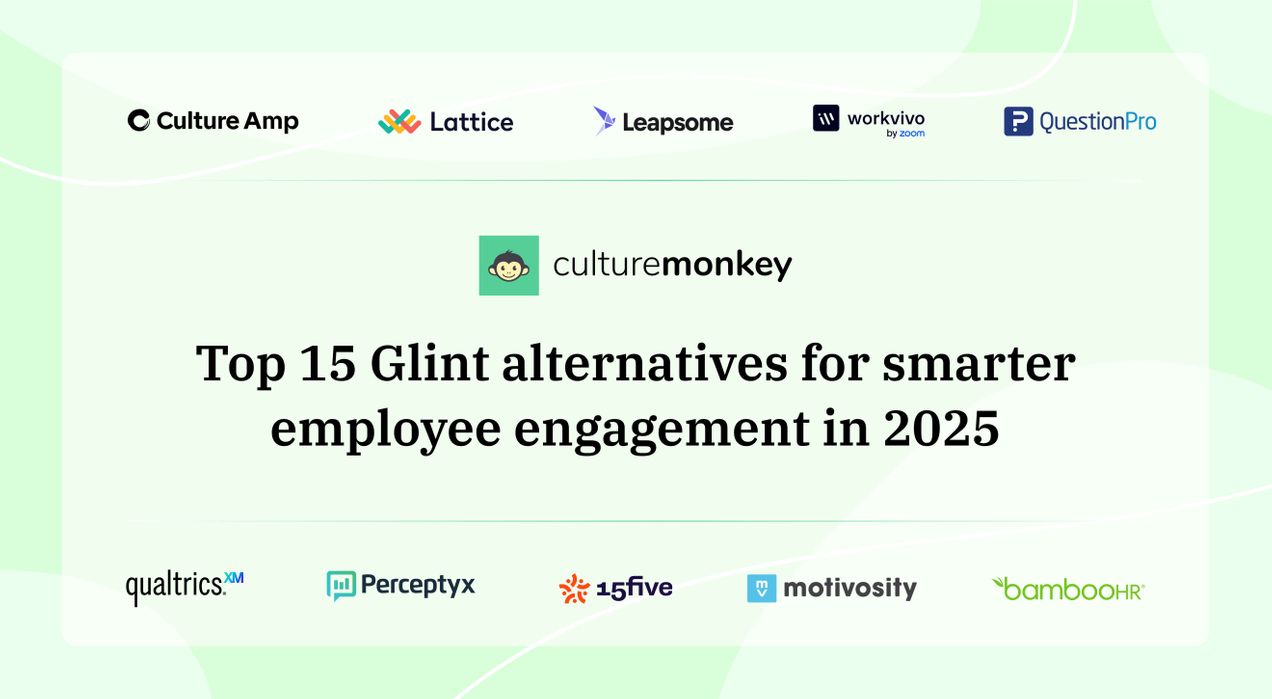How employee relationship management shapes a positive, engaged company culture

Musicians jamming together—not reading from sheet music, not rehearsing for weeks—just listening, responding, and building something beautiful in real time. One starts a rhythm, another picks up the melody, someone else adds harmony.
No one’s trying to outshine the other—they’re just in sync, making space for each other, lifting the whole sound.
That’s what great employee relationships feel like. They’re not forced or formal. They’re built on mutual trust, timing, and the unspoken understanding that everyone’s here to make the whole thing work better.
When people feel seen, supported, and understood, they bring their full selves to work. And that kind of employee connection doesn’t just make the day better—it transforms the culture.
In this blog, we’ll explore how managing relationships at work isn’t just about reducing friction—it’s about creating rhythm, energy, and momentum that keeps your culture thriving.
What is employee relationship management?
Employee relationship management (ERM) is the strategic approach organizations use to build, nurture, and maintain strong relationships between employers and employees. It goes beyond simply having an “open-door policy” or throwing a team lunch once in a while. Instead, ERM is about creating consistent, trust-based interactions that make employees feel heard, valued, and supported while adhering to employment law.
At its core, ERM includes a range of practices—from effective communication and performance feedback to conflict resolution and recognition programs. It’s not just a “feel-good” initiative—it directly impacts how engaged, motivated, and loyal your employees are. A strong employee relationship management framework ensures that people don’t just clock in and out—they actually want to be part of the organization, and issues are addressed in a timely manner.
Now, while people often ask what employee relations is or what staff relations is, ERM is the broader umbrella that includes both. It’s the intentional design of every touchpoint between leadership and teams, ensuring transparency, respect, and shared accountability.
What makes ERM different is that it doesn’t rely solely on HR. Managers, team leads, and even peers play a role in creating a positive employee experience. In short, management of employee relations isn’t a side task—it’s central to your culture, retention, and reputation, especially when addressing employee relations issues. And if done right, it can prevent misunderstandings, boost morale, and drive long-term growth.
Importance of employee relationship management

Building a thriving workplace starts with strong relationships. Employee relationship management (ERM) isn’t just about reducing conflict—it’s about creating a culture where trust, communication, and collaboration naturally flourish. Here's why it's so crucial in today’s dynamic work environment:
- Boosts employee engagement: When employees feel seen, heard, and respected, they’re more likely to stay emotionally invested in their work. A thoughtful employee relationship management framework strengthens the sense of belonging, which fuels motivation and commitment across teams.
- Reduces workplace conflict: Good relationships don’t eliminate conflict, but they make it easier to navigate. Proactive communication and mutual respect can stop minor misunderstandings from spiraling into full-blown disputes, saving everyone stress and time.
- Encourages retention and loyalty: People don’t just leave bad jobs—they leave poor relationships. Strong employee relations reduce turnover by fostering trust and giving employees reasons to stay, even during periods of change or uncertainty.
- Supports employee development: When employees feel connected to their managers and teams, they’re more open to feedback and growth opportunities. Relationship-driven environments naturally promote mentorship, learning, and career development.
- Drives better collaboration: Healthy staff relationship management improves teamwork by breaking down silos. Employees are more willing to share ideas, problem-solve together, and contribute to team goals when relationships are built on mutual trust.
- Reflects company values: The way you manage employee relations shows what your company truly stands for. Respectful, transparent interactions reinforce organizational values far more effectively than a poster on the wall ever could.
- Strengthens organizational resilience: In times of crisis or major change, strong employee relations act like glue. When people trust each other and their leadership, they’re more likely to adapt, stick together, and help the company weather any storm.
6 Benefits of employee relationship management

While the importance of employee relationship management is clear, the benefits go even further, impacting everything from daily morale to long-term business success. Here are six distinct advantages of having strong ERM practices in place:
- Improves mental well-being: When employees feel supported and respected, it reduces stress and workplace anxiety. Healthy employee relations promote psychological safety, making it easier for individuals to speak up, ask for help, or share concerns without fear of judgment.
- Fosters innovation: Teams with strong internal relationships feel safer taking risks and sharing bold ideas. By creating an environment where input is welcomed and feedback is constructive, employee relations strategies help spark creative problem-solving and innovation.
- Enhances organizational reputation: Companies known for strong employee relations often enjoy better employer branding. Happy employees become advocates, drawing in top talent and contributing to positive word-of-mouth across industry circles and review platforms.
- Increases accountability: A well-structured employee relationship management framework encourages ownership. When relationships are built on mutual trust, employees feel more responsible for their work and outcomes, leading to a higher standard of performance.
- Makes onboarding smoother: New hires integrate faster in organizations with solid staff relationship management. When teams are welcoming and communication is clear, onboarding feels less like a corporate crash course and more like joining a community.
- Reduces legal risks: Clear, consistent communication and fair treatment help avoid misunderstandings that could lead to legal issues. Good employee relations practices often act as a first line of defence against workplace complaints or compliance missteps.
Principles of employee relations

At the heart of strong employee relationships are a set of guiding principles that ensure fairness, trust, and respect. These principles not only establish clear expectations for both management and employees but also help to foster an environment where communication and collaboration thrive, contributing to a positive company culture.
Here are the key principles that form the foundation of effective employee relations:
Fairness and equity
Treating employees fairly and equally is crucial in building trust and loyalty. Whether it’s in terms of promotions, pay, or opportunities for growth, fairness ensures employees feel valued for their contributions and are not subject to discrimination or bias.
Open and transparent communication
A culture of open communication is a cornerstone of positive employee relations. Regular feedback, honest conversations, and clarity around company goals and changes ensure everyone is on the same page, reduce misunderstandings, and ultimately boost employee productivity.
Respect and dignity
Respecting employees' individual needs, values, and perspectives strengthens relationships. Creating a culture where employees feel their dignity is upheld and their opinions matter leads to a more harmonious and productive workplace, thereby focusing on building strong employee relationships.
Accountability and responsibility
For effective employee relations, both employees and management must hold themselves accountable. Acknowledging mistakes, taking responsibility, and making improvements based on feedback helps build a culture of integrity and reliability.
Conflict resolution
Conflicts are inevitable, but how they are handled makes all the difference. Effective employee relationship management focuses on addressing issues fairly, swiftly, and without bias, ensuring that both parties feel heard and a solution is found that benefits everyone.
Recognition and reward
Recognizing employees’ hard work and contributions fosters a positive work environment. Whether through formal programs or everyday gestures, regular acknowledgment encourages continued dedication and reinforces desired behaviors and outcomes.
Key aspects of employee relationship management
Employee relationship management isn’t about quick fixes or isolated perks—it’s about consistent, intentional actions that show employees they matter. From communication to recognition, the following aspects create a blueprint for long-term engagement and trust-building.
- Enhances communication: Consistent, two-way communication is the foundation of strong employee relationships. It helps avoid confusion, builds clarity around expectations, and keeps everyone connected to the broader mission of the company.
- Conduct team-building activities: From workshops to casual hangouts, team-building builds camaraderie and trust. These activities humanize coworkers, strengthen collaboration, and break down barriers between departments or hierarchies.
- Work-life balance: Supporting personal time isn’t just good ethics—it’s good business. Prioritizing work-life balance reduces burnout and shows employees you value their well-being, not just their output.
- Gather feedback: Employees who are regularly asked for feedback feel respected and involved. This practice surfaces issues early, builds trust, and helps shape better policies and workplace improvements.
- Investment in employees: Supporting career growth through training, mentorship, or upskilling shows you’re committed to their future. It sends a clear message: you’re not just managing staff—you’re growing people.
- Communication: Yes, again—because it's that important. Open channels across departments and leadership levels ensure that employees aren’t just talked to—they’re included in the conversation.
- Recognition: Whether public or private, timely recognition fuels morale. A simple “thank you” or shout-out for effort reminds employees that their contributions are seen and appreciated.
- Training and development: Offering relevant learning opportunities helps employees feel empowered and supported. It keeps skills fresh, builds confidence, and signals that their growth matters to the company.
- Appreciation and gratitude: Appreciation goes beyond bonuses. It includes everyday acts like listening, expressing thanks, or acknowledging someone’s extra effort—these small gestures build lasting loyalty.
- Celebrate achievements: From birthdays to project milestones, celebration reinforces culture. It encourages team spirit and helps employees feel like an essential part of the company’s journey.
- Establish goals and reinforce values: Shared goals and core values unify teams. Clear direction helps employees stay aligned and motivated, while values offer a compass during decisions and change.
- Increases productivity: A positive, relationship-driven environment motivates employees to give their best. When people feel supported and trusted, they’re more focused, efficient, and results-driven.
- Reduces turnover: Employee relationship management lowers attrition by creating an emotional connection with the workplace. When people feel respected and valued, they’re far less likely to leave.
- Use communication applications: Digital tools like Slack, Teams, or intranet platforms keep hybrid and remote teams in sync. These apps ensure seamless communication, quick updates, and informal chats that mimic hallway moments.
- Benefits for employees: ERM creates a ripple effect—better communication, stronger support systems, and more opportunities to grow. The result? More engaged employees and a fulfilled workforce.
- Boosts employee morale: Consistent engagement and recognition significantly lift morale. When employees feel supported in their roles and respected as people, their enthusiasm becomes contagious.
- Communicate with your employees face-to-face: Digital tools are great, but nothing beats a real conversation. Face-to-face interactions, even virtually, foster connection and build deeper trust and understanding.
- Communication and transparency: Transparency removes guesswork and creates psychological safety. When leadership shares openly, employees feel like insiders, not just task-doers.
- Embrace diversity: Inclusive environments lead to stronger ideas and better relationships. When people feel free to be themselves, it enriches team dynamics and nurtures mutual respect.
- Empowers employees: Empowerment comes from trust, autonomy, and access to information. When employees have a say in how they work, they take greater ownership and initiative.
- Encourages advocacy: Happy employees become ambassadors. When your internal culture is solid, employees naturally recommend your company to peers, boosting recruitment and brand reputation.
- Encourages leadership skill development: Good relationships encourage emerging leaders to step up. Employees feel safe taking on more responsibility and developing leadership traits when supported by a strong ERM.
- Exemplary organizational culture: ERM shapes culture through everyday actions. A workplace with strong relationships naturally becomes one where respect, accountability, and collaboration are the norm.
- Focus on mission and vision: Clear, consistent messaging about your company’s mission and vision keeps everyone aligned. Strong relationships help reinforce these values in daily operations and decisions.
Employee relationship management vs employee engagement: What’s the difference?
While both employee relationship management (ERM) and employee engagement aim to create a healthier work environment, they’re not interchangeable. ERM is the how—the systems and actions behind maintaining good relationships. Engagement is the result—the emotional and behavioral commitment that stems from those efforts.
| Aspect | Employee Relationship Management (ERM) | Employee Engagement |
|---|---|---|
| Definition | A strategic approach to managing interactions between employers and employees. | The emotional and psychological commitment an employee has toward their work and company. |
| Focus | Processes, policies, communication, and behavior management. | Motivation, satisfaction, and enthusiasm at work. |
| Goal | To build trust, resolve issues, and maintain a healthy employer-employee dynamic. | To boost productivity, retention, and job satisfaction. |
| Method | Through feedback loops, conflict resolution, recognition, and transparency. | Through inspiring leadership, purpose-driven work, and personal growth opportunities. |
| Responsibility | Typically led by HR and people managers. | A shared effort between leadership, managers, and employees. |
| Measurement | Assessed through relationship health metrics, turnover rates, and internal communication. | Measured via engagement surveys, productivity, and employee Net Promoter Score (eNPS). |
| Outcome | Stronger relationships and lower conflict. | Higher performance, innovation, and loyalty. |
How to build positive employee relations?

Creating strong employee relations doesn’t happen by chance—it requires ongoing, intentional actions that show your people they matter. It’s about creating a culture of respect, consistency, and open dialogue, which can be further enhanced through employee appreciation events. Here are the most effective steps to help you build and maintain positive relationships at work.
- Foster open communication: Make it easy for employees to speak up without fear. Encourage feedback, questions, and honest conversations—whether during 1:1s, team check-ins, or anonymous surveys. Transparency builds trust from the ground up.
- Set clear expectations: Confusion kills morale. Ensure every employee understands their role, responsibilities, and how their work contributes to broader company goals. Clarity helps prevent miscommunication and unnecessary conflict.
- Recognize and reward contributions: Consistent appreciation boosts morale and deepens loyalty. Recognize achievements both big and small—verbally, publicly, or through tangible rewards. A “thank you” goes a long way.
- Be fair and consistent: Avoid favoritism or inconsistent policies. Treat all employees equitably, follow through on promises, and ensure that rules apply evenly—this builds respect and prevents resentment.
- Address conflicts early and constructively: Don’t let issues fester. Tackle conflicts directly, but respectfully, aiming to understand both sides. A proactive conflict resolution approach protects trust and team harmony.
- Invest in employee growth: Offer training, mentorship, and opportunities to upskill. When employees see that you care about their development, they’re more committed and driven in return.
- Encourage work-life balance: Support flexible schedules, PTO, and mental health breaks. Employees perform better and stay longer when they’re not stretched thin or constantly overwhelmed.
How to handle conflict and disputes without damaging relationships?
Conflicts in the workplace are natural, but they can either strengthen or damage relationships depending on how they’re managed. The key is to approach disputes with empathy, respect, and a solution-focused mindset.
Here are the effective strategies for handling conflict while preserving professional relationships.
- Listen actively and with empathy: Before jumping to conclusions or offering solutions, take the time to genuinely listen to the other person’s point of view. Active listening—where you make eye contact, nod in acknowledgment, and refrain from interrupting—helps the other person feel heard and valued.
- Focus on the issue, not the individual: When conflicts arise, it's important to keep the conversation focused on the specific issue rather than attacking the person involved. Avoid using blame language or personal attacks that can escalate tensions. Instead, focus on the problem at hand and how it impacts the team or the organization.
- Acknowledge emotions and de-escalate the situation: Conflicts often trigger strong emotions, and ignoring these can worsen the situation. Acknowledging the emotions involved shows empathy and can help de-escalate the tension. By saying things like, “I can see this situation is frustrating for both of us,” you validate the emotional experience, which can make the other person feel understood and less combative.
- Involve a neutral third party for mediation: In some cases, conflicts may be too challenging for the involved parties to resolve on their own. When this happens, bringing in a neutral third party such as a manager or HR professional can help mediate the situation. A mediator can ensure both sides are heard equally and help navigate sensitive topics.
- Follow up and reinforce the solution: Once a resolution is agreed upon, it’s important to follow up to ensure that both parties are committed to the solution and that the relationship remains intact. A quick follow-up conversation can clear up any lingering concerns and reinforce that the issue has been resolved in a way that benefits both sides.
How does DEIB and psychological safety elevate employee relationships?
Diversity, equity, inclusion, and belonging (DEIB) initiatives, combined with psychological safety, create an environment where employees feel respected, valued, and empowered to contribute their best work.
When these elements are prioritized, employee relationships become stronger, more collaborative, and more trusting. Here are five ways DEIB and psychological safety positively impact workplace relationships.
- Encourages open dialogue and authentic expression: When employees feel psychologically safe, they are more likely to share their ideas, feedback, and concerns without fear of judgment or retaliation. This openness fosters a culture of trust, where individuals can express themselves authentically, leading to stronger relationships.
- Reduces bias and promotes fairness: DEIB initiatives actively work to reduce biases—whether related to gender, race, or other personal traits—and ensure that all employees are treated fairly. This fairness strengthens relationships because employees are less likely to feel alienated or undervalued.
- Builds a culture of respect and empathy: Psychological safety ensures that employees can disagree without fear of their opinions being ridiculed or ignored. It promotes a culture where differences are not only accepted but also valued. When combined with DEIB efforts, the workplace becomes a space where employees from all backgrounds can relate to one another.
- Boosts collaboration and teamwork: When employees feel safe to voice differing opinions and contribute their unique experiences, collaboration thrives. DEIB initiatives ensure that team members from diverse backgrounds bring valuable insights to the table. Psychological safety allows them to share these perspectives openly, creating more inclusive and effective teamwork.
- Increases employee engagement and retention: When employees feel psychologically safe and see that their workplace values diversity and inclusion, their sense of belonging increases. Employees who feel connected to their organization are more engaged and less likely to leave. The result is a more stable, committed workforce where positive relationships are at the core of employee satisfaction.
Examples of effective ERM practices in different industries
Employee Relationship Management (ERM) strategies vary across industries but share a common goal of fostering positive employee relationships. Here are the top 5 employee relations examples of how different sectors have successfully applied ERM practices, showcasing their effective employee relations strategy.
1. Technology industry: Transparent communication and flexibility
In the tech industry, companies like Google and Microsoft prioritize transparent communication, offering employees regular feedback and open forums with leadership. They also offer flexible work schedules and remote options, allowing employees to balance personal and professional life, improving engagement and relationships, which ultimately boosts customer satisfaction.
2. Healthcare industry: Team building and support networks
Hospitals and healthcare organizations invest in team-building activities and peer support networks to improve communication and reduce stress among staff. These initiatives foster a sense of belonging, enabling healthcare workers to collaborate more effectively, strengthening their relationships, and reducing burnout.
3. Manufacturing industry: Recognition and career development
Manufacturers like Toyota focus on employee recognition programs and clear career development paths. Regular acknowledgment of achievements and opportunities for growth, through mentoring programs, builds loyalty and strengthens relationships between employees and management, leading to lower turnover.
4. Retail industry: Open door policies and employee involvement
Retail giants such as Starbucks foster strong relationships by implementing open-door policies and involving employees in decision-making. This approach helps employees feel heard, valued, and more connected to the company’s goals, enhancing team morale and collaboration.
5. Education industry: Professional development and conflict resolution
In the education sector, institutions like Harvard University offer professional development programs focused on communication and conflict resolution. These initiatives promote positive relationships among faculty and staff, ensuring a productive and collaborative work environment.
Best practices for remote and hybrid relationship management

Managing employee relationships in remote and hybrid environments requires tailored strategies that ensure effective communication and collaboration, regardless of location. Here are the best practices for maintaining strong employee relationships in these flexible work settings.
- Foster open communication channels: In remote and hybrid work environments, clear and open communication is vital. Companies should establish regular check-ins, use messaging platforms, and encourage feedback to ensure employees stay connected and informed. This transparency helps prevent misunderstandings and keeps everyone aligned.
- Prioritize virtual team-building activities: Since remote employees miss out on spontaneous in-office interactions, virtual team-building activities are essential. Regular virtual hangouts or collaborative challenges can help remote workers bond, promoting a sense of camaraderie and improving relationships despite physical distance.
- Provide flexibility and trust: Employees in hybrid or remote settings value autonomy. By offering flexible work hours and trusting employees to manage their schedules, companies can enhance job satisfaction. This trust fosters a positive relationship, encouraging accountability and commitment from remote workers.
- Ensure inclusivity in meetings: For hybrid teams, it’s crucial to ensure that both in-office and remote employees are equally included in meetings. Using video conferencing and collaborative tools ensures that everyone has a voice, preventing feelings of isolation or neglect among remote workers.
- Use technology to stay connected: Leveraging the right technology, such as project management tools and video calls, can keep teams connected. These tools help bridge the gap between in-person and remote workers, ensuring everyone is on the same page and reinforcing strong relationships despite the physical separation.
- Recognize achievements and offer feedback: Regular recognition is crucial for maintaining strong relationships, especially in remote teams. By celebrating milestones and giving constructive feedback, employers show employees they are valued, which strengthens the overall team dynamic and boosts morale.
- Maintain a strong company culture: Even in hybrid or remote settings, it’s essential to maintain a strong company culture. Companies should clearly communicate their values and mission, encouraging employees to engage in activities that promote the organization’s culture, even from afar. This sense of belonging fosters deeper relationships with the company and colleagues.
What role does HR play in employee relationship management?
Human resources plays a critical role in shaping and maintaining positive employer-employee relationships by creating an environment that supports communication, growth, and well-being. Here are five ways HR contributes to effective Employee Relationship Management (ERM).
- Mediating conflict and resolving disputes: HR professionals act as neutral parties in resolving conflicts and disputes between employees or between employees and management. By facilitating open dialogue and fair resolution, HR helps maintain healthy working relationships and prevents issues from escalating.
- Developing clear policies and guidelines: The human resources department ensures that workplace policies are clear, fair, and accessible to all employees. These guidelines cover important aspects of employee behavior, performance expectations, and dispute resolution, providing a framework that fosters mutual respect and trust between employees and management.
- Implementing employee engagement programs: HR is responsible for developing and implementing employee engagement initiatives with employee relationship management software. These programs might include surveys, feedback mechanisms, and team-building activities that allow employees to feel heard, valued, and more connected to the organization.
- Supporting Professional development: HR invests in employee growth by offering training programs, mentorship, and career development opportunities. This not only helps employees advance their skills but also builds trust in the organization, as it shows a genuine interest in their success and well-being.
- Promoting workplace culture and inclusivity: HR leads efforts to create an inclusive workplace culture where all employees feel valued and respected. By promoting diversity, equity, and inclusion (DEI) initiatives, HR ensures that employees can form positive, supportive relationships regardless of their backgrounds.
The role of anonymous employee surveys in strengthening relationships
Anonymous employee surveys play a significant role in fostering trust and openness between employees and management. By giving employees a safe platform to voice their concerns and suggestions, HR can improve communication and strengthen relationships within the organization.
Here are five ways anonymous surveys contribute to better employee relationships.
- Encouraging honest feedback: Anonymous surveys provide employees with a platform to express their true feelings without fear of retribution. This encourages honesty and allows management to gain insights into issues such as workplace culture, leadership, and employee satisfaction, which may not be shared openly in face-to-face settings.
- Identifying areas for improvement: By regularly conducting anonymous surveys, HR can identify patterns or recurring issues within the organization. Addressing these concerns promptly can prevent small problems from escalating, improving the overall workplace environment, and strengthening relationships between employees and management.
- Promoting employee engagement: When employees see that their feedback is valued and acted upon, it boosts engagement. Knowing that their opinions lead to real change helps create a sense of connection to the organization, fostering loyalty and stronger working relationships across all levels.
- Enhancing trust between employees and management: Anonymous surveys build trust by showing employees that management is genuinely interested in their opinions and willing to make improvements based on their feedback. This transparency helps create a more collaborative atmosphere, where employees feel more comfortable and confident in their relationships with leadership.
- Supporting a positive workplace culture: By regularly collecting anonymous feedback, HR can gauge the health of the company’s culture. This ongoing feedback loop helps maintain a positive work environment where employees feel respected, heard, and empowered to contribute to the organization’s success.
Conclusion
Employee Relationship Management (ERM) is a cornerstone for creating a positive, productive, and engaged workplace. By fostering open communication, resolving conflicts constructively, and investing in employee development, organizations can build stronger relationships that lead to higher morale, lower turnover, and increased productivity.
HR teams are central to nurturing strong employee relationships by championing open dialogue, supporting professional growth, and ensuring a healthy work culture. To make these efforts more impactful, leveraging the right tools is essential—and that’s where CultureMonkey comes in.
As a leading employee engagement platform, CultureMonkey enables organizations to gather honest, anonymous feedback through pulse and lifecycle surveys, helping HR uncover relationship challenges early. Its advanced sentiment analysis, multilingual survey capabilities, and real-time dashboards empower HR to act swiftly and inclusively.
By consistently listening to employees and aligning actions with their needs, CultureMonkey helps build a culture of trust, transparency, and mutual respect—key drivers of successful employee relationship management.
Summary
FAQs
1. What are the biggest challenges in employee relationship management today?
The biggest challenges in ERM today include managing remote or hybrid workforces, ensuring clear communication, addressing employee disengagement, maintaining inclusivity, and handling conflicts efficiently. These issues require ongoing attention and adaptable strategies to keep employee relationships healthy, especially in fast-evolving work environments.
2. How often should HR check in on the health of employee relationships?
HR should check in on employee relationships regularly—ideally, quarterly or biannually—through surveys, one-on-one meetings, or team feedback sessions. Frequent check-ins help identify emerging concerns, allowing HR to address issues before they affect overall morale and productivity, ensuring a proactive approach to maintaining healthy workplace relationships.
3. Can technology replace human connection in employee relationship building?
Technology can enhance communication and streamline processes, but it cannot fully replace the human connection in relationship building. While tools like video calls and messaging apps facilitate communication, face-to-face interactions, empathy, and emotional intelligence remain essential for establishing trust and building meaningful relationships with employees.
4. How do you rebuild employee relationships after a Major organizational change?
Rebuilding employee relationships after major organizational changes requires transparency, consistent communication, and addressing employee concerns. HR should provide support, offer opportunities for feedback, and focus on rebuilding trust by involving employees in the transition process, ensuring they feel valued and engaged during the change.
5. What soft skills are most important for effective relationship management in teams?
Key soft skills for effective relationship management include active listening, empathy, conflict resolution, communication, and emotional intelligence. These skills help leaders understand team dynamics, address concerns proactively, and maintain a positive, collaborative environment, fostering strong, trusting relationships among team members, which is crucial for effective performance management.



